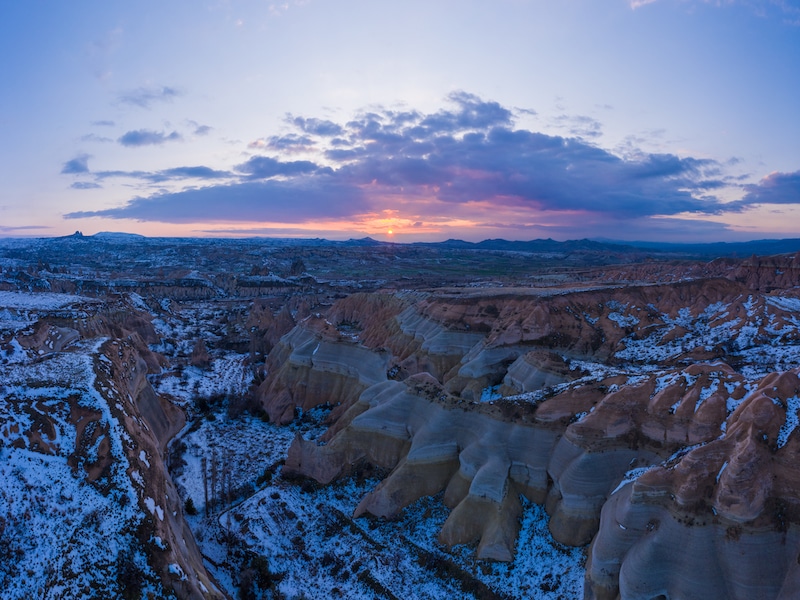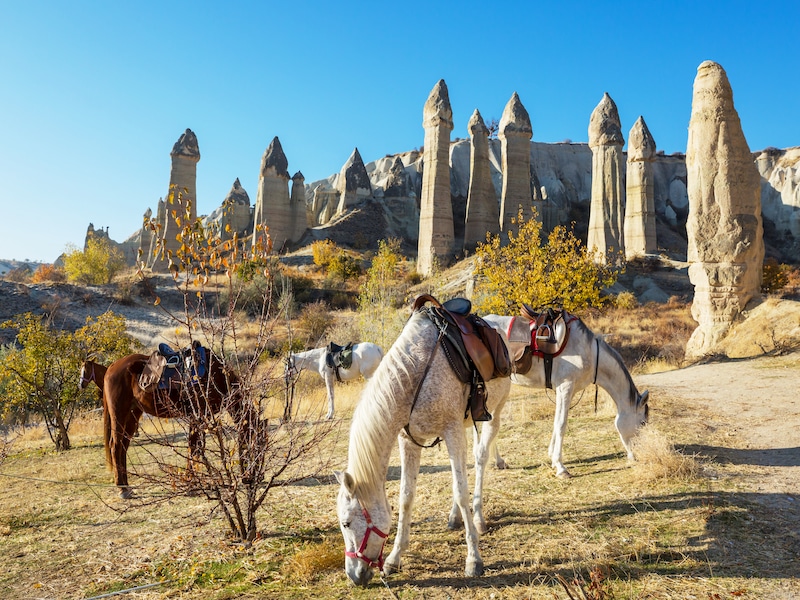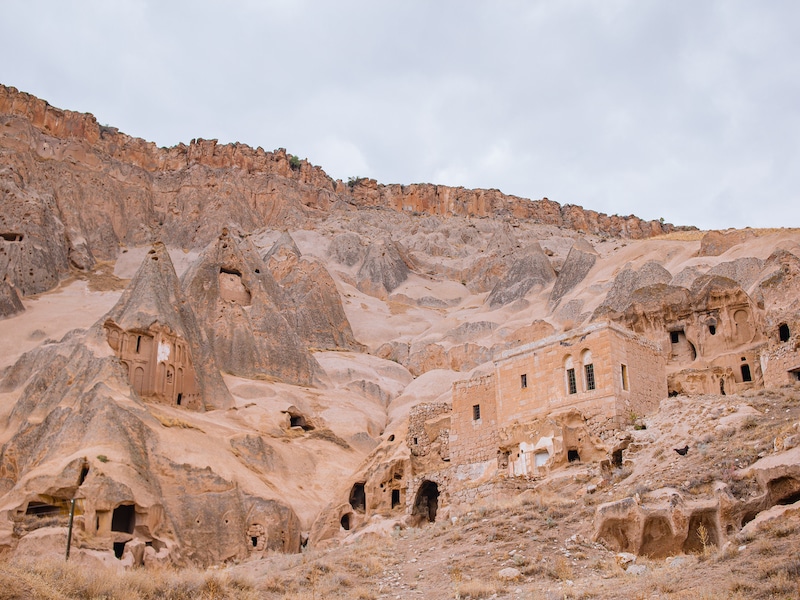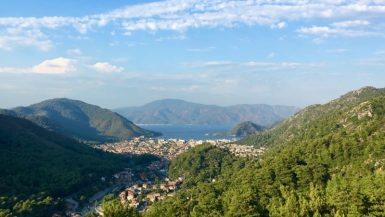
Turkey might be well-known and well-loved for its bustling capital and Mediterranean resorts, but the semi-arid central region of Cappadocia is in a league of its own when it comes to once-in-a-lifetime holidays. With its lunar landscape, Bronze Age history, deep canyons, and enchanting balloon festivals, it won’t take long to convince you that Cappadocia is certainly worth visiting.
Cappadocia stretches for around 5,000 square kilometers, right in the middle of the Anatolian side of Turkey. The vast region is landlocked, but this certainly doesn’t take away from the appeal. Most of the action centers around the Göreme Valley, best known for its “fairy chimney” valleys, cave homes, and underground cities. Still, some things are more worth seeing than others, and it’s not all hot air balloon rides and perfect Instagram shots.
There’s a lot more to uncover in Cappadocia and our guide includes all the highlights. From the unique homestays to the great local wine, here are our top 7 reasons to visit. Let’s get into it.
The Hot Air Balloon Rides

Cappadocia, and Göreme in particular, is synonymous with images of soaring “fairy chimneys” beneath skies of colorful hot air balloons. The region might have more to offer than its flying festivals, but they’re a great place to start and one of the top reasons that make Cappadocia such a truly incomparable destination.
Hot air balloon rides are definitely worth the hype in Cappadocia and it’s the perfect place to tick this experience off your bucket list. You might think the sea of other hot air balloons will ruin the ambiance too, but the reality is far from it. Hovering in the sky with not only the sweeping views of Monks Valley and its fairy chimneys, but also the accompaniment of 165 other colorful balloons, is nothing short of magical.
It might consume a big portion of your budget and Cappadocia is generally more expensive than the rest of Turkey to start with, but watching the sun rise behind historic volcanoes from your own little spot in the sky is worth every penny.
The Accommodation

Just as synonymous with Cappadocia as its hot air balloon skies are the Bronze Age homes carved into the valley walls by cave dwellers known as troglodytes, as many as 5,000 years ago. And what could be a better way to experience them than in a unique homestay, of which Cappadocia has hundreds?
You may not get a real taste of what life used to be like in Cappadocia in the Bronze Ages as we can’t imagine troglodytes had running water, wifi, and towels, let alone subterranean swimming pools, spas, and restaurants, but many of the cave hotels are renovated from real original ancient homes, and they’re the perfect place to experience the history of Cappadocia with a hint of luxury.
Göreme itself is a historical national park and UNESCO World Heritage Site, not to mention a great place to stay. But there are hundreds of hotels in the region at large to choose from, and these are just some of the best ones for an authentic cave-dweller’s experience on any budget:
Narcissos Cave Hotel ($) – Soak up all the excitement of a unique cave stay, without the high price tags, in this quaint and authentic hotel with mountain village views, a spacious terrace, communal hot tub, and buffet breakfast included.
Yunak Evleri Cappadocia ($$) – With rooms dating back to the 5th century, some offering their own private terraces for admiring the fairy chimneys of Urgup, Yunak Evleri is a luxurious hotel carved into the mountain cliff with an on-site library, marble bathrooms, indoor swimming pool and spa, and a 19th-century Greek mansion.
Seraphim Cave Hotel ($$$) – Grand five-star luxury with expansive gardens, hammam access, on-site dining, marble floors, and undisturbed canyon views, Seraphim Cave Hotel has it all if you’re a lover of the finer things in life.
The Weather

You probably associate Turkey with scorching Mediterannean summers and semi-arid landscapes, and you wouldn’t be wrong to do so. The country has one of the most desirable climates in Europe and is home to some of the continent’s hottest regions, and Cappadocia is one of them.
You can expect dry heat and daily highs of around 90 degrees Fahrenheit from June to September, with temperatures regularly exceeding 100 degrees in the Cappadocia region. Nearly all activities are outdoors, which means things can get a bit sweaty, especially considering the huge tourist crowds that flock to Cappadocia in the summer. Still, the cave dwellings are cool and serene, and since the best hot air balloon rides take to the skies at sunrise, you’ll get some forgiving early morning temperatures and mostly clear conditions for your ride.
On the other hand, to many visitors’ surprise, Cappadocia also gets freezing in the winter months and snow can fall from as early as November and continue intermittently until March. It usually doesn’t stick until December, but when it does, Cappadocia offers a whole different experience and one that is arguably even more magical.
Although hot air balloon season is in the summer, you can still catch a ride in the winter months in the right conditions and the towering rock formations and indented valleys look spectacular under a dusting of snow. January is the coldest month but the most underrated time to visit the region with ample snowfall and a whole host of other exciting outdoor activities to do.
The underground cities are still open and the cave hotels are even cozier. The balloon rides are less regular and have to plan around the wind conditions, but if you do manage to go up, the solitude and crisp air are indescribably refreshing.
What’s more, you can even ski in Cappadocia, and often for much cheaper than in Western European resorts. Erciyes is just over an hour by car from Göreme and is the biggest ski resort in Turkey. Many visitors make the common misconception that Cappadocia is hot all year round, but the diversity of this desert’s climate is an undeniable pull factor.
The Landscapes

Cappadocia is amazing from a hot air balloon, but the reason they’re so popular in the first place is because of the unique and distinct scenery, and there are tons of other ways to experience it. If you can’t afford a hot air balloon ride, or if you’re just looking for more things to do, you’ll be spoilt for choice when it comes to exploring the Göreme Valley, from hiking adventures to ATVs tours, horseback riding, and more.
Head up to the top of Love Valley first thing in the morning and the experience isn’t too far off from being in a hot air balloon itself. You’ll be meters from the dozens of balloons that fill the sky here and be able to get that perfect sunrise shot as if you were in the sky.
Most locals will also tell you that if you haven’t been hiking, you haven’t truly experienced Cappadocia. Some of the best trails include Pigeon Valley to Uchisar Castle, finishing at Love Valley, as well as Red Valley, Meskendir Valley, and Rose Valley, all offering completely different scenery from deep canyons to spiky stalagmite fields, passing rivers, forests, and ancient monasteries.
Most of the hikes aren’t too challenging but you do need some physical fitness to navigate the slippery and uneven paths. If you’d rather take the weight off your feet, opt for a horseback riding tour for equally impressive views and double the fun.
As we’ve mentioned, you can also ski in Cappadocia if you come at the right time of year. And if you’re after something less demanding, any of the many rooftop terraces, belonging to hotels and restaurants scattered around Göreme are equally impressive places to enjoy the hot air balloon seas and sweeping valley views without having to take to the skies yourself. Due to popularity, you’ll often have to reverse a spot and put down a minimum spend, but in the low season, you could have the space to yourself.
The Human History

Amidst all the outdoor adventure and luxury dwellings, you can’t forget about the people who started it all: the troglodytes who’ve been living in caves in this region of Turkey for thousands of years.
Cappadocia’s history goes back so far that researchers can’t even figure out who the first civilizations to start inhabiting the mountainsides were, but it’s thought that human settlement in Cappadocia dates back to the Paleolithic era, roughly 2.5 million years ago. Visitors today can still enjoy their underground cities and all the amazing stories written on the walls.
Just one of Cappadocia’s fascinating stories is its Christian heritage, in a largely Muslim country. Many of the subterranean settlements in the region were built during the Byzantine era by early Christians who actually used the network of caves to shield from Muslim Arabs during the Arab-Byzantine wars in the 11th century. Although widely persecuted for their religion, early Christians were able to spread the word of God from the protection of their rock-face monasteries, meaning Cappadocia has had a monumental part to play in how Christianity has shaped the culture of not only Turkey but the world at large.
The People

Still, it’s not only the people in Cappadocia’s past that have enriched the region so significantly. One of the first things you’ll notice when traveling around, eating, drinking, booking tours, and asking for directions, is that Cappadocians are notoriously friendly. The people of Turkey are generally kind and hospitable wherever you go, but they bring this to another level in Cappadocia.
It’s not uncommon to be invited on free hikes, or into private cave homes for evenings that might even end in traditional Turkish guitar performances and home-cooked meals. These are all experiences that previous travelers have reported, and all it takes is a few friendly fireside conversations and socializing with business owners.
Cappadocians are always happy to help and they put family values at the heart of everything. To truly experience Cappadocia outside of the luxury hotels and ubiquitous itineraries, consider stepping off the beaten track, staying outside of Göreme, and ditching the five-stars for a family-owned homestay and you never know what adventures might ensue.
The Wine

Another thing you might not know about Cappadocia is that it’s actually a rich wine region. Yes, you read right. If it wasn’t fantastical enough with its freezing deserts and prehistoric settlements, all of that verdant volcanic soil that’s responsible for Cappadocia’s million-year-old fairy chimneys is also perfect for growing grapes.
Wine tasting isn’t huge in Turkey, especially considering the many laws in Islam that condemn the consumption of alcohol. In fact, in regions like Konya, you’ll even struggle to buy alcohol anywhere, even as a tourist, but Cappadocia is certainly a change of pace.
Fireside glasses of red are perfect on chilly evenings, and refreshing local whites go perfectly with sunset evenings spent on dimly lit rooftops. The Gülşehir and Sofular vineyards in Cappadocia are two of the few territories in the world where grapes thrive thanks to volcanic minerals and dramatic changes in temperature between night and day. They stand at an altitude of between 900 and 1,300 meters and are home to native Anatolian grapes like Kalecik Karası, Boğazkere, Emir, and Narince, as well as some well-known international varieties like Chardonnay and Shiraz.
The generous winds that have shaped Cappadocia’s fairy chimneys assist in the harvesting process and there are around 30 different grape varieties that can be produced in the region. Head to Avanos, the small pottery town around 10 minutes from Göreme on the banks on the Kızılırmak River for some of the best wine shops and wine tasting experiences.
How many days do you need in Cappadocia?
Cappadocia is a vast region with so much to do and see. You could spend weeks exploring its 5,000 square kilometers and still not uncover all of its mysteries, but if you don’t have that much time, we recommend at least four to five days to see the main highlights, and more if you have some extra adventures in mind like skiing. You should allow at least three mornings if you really want to do a balloon ride too, as cancellations due to weather are common.
When is the best time to visit Cappadocia?
Cappadocia is one of Turkey’s most popular vacation destinations, so it’s hard to beat the crowds. The most popular time to visit is in the summer months, but high temperatures can make outdoor activities very sweaty and the summer sees the highest prices. Consider visiting at the end of April, or between September and October instead for pleasant temperatures and good balloon ride chances. The beginning of April is very windy and so balloon rides are often canceled. And if you’re less bothered about taking to the skies, you could even visit in the depths of winter for a whole different experience.
How do you get from Istanbul to Cappadocia?
Istanbul is over 700 kilometers away from Cappadocia, that’s around eight hours’ driving distance, so the most popular way to make the trip is by plane. Turkish Airlines and Pegasus Air operate regular flights to both of Cappadocia’s regional airports: Kayseri Erkilet and Nevsehir Airport, and the flight time is around 80 minutes. You can also take the train for a cheaper price (around 20 USD) but the journey takes 11 hours on average.


